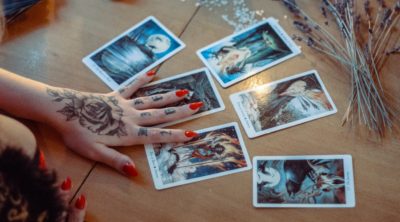
Demeter, the Goddess of Agriculture, was one of the most important goddesses of the ancient Greek pantheon. This SpiritualRay article features some interesting myths and facts about this Greek goddess.
Demeter has been associated with the constellation Virgo. In many artistic depictions, she is Virgo, the Virgin, and holds a sheaf of wheat in her hand.
The society of ancient Greece was agrarian in nature. About 80% of the ancient Greek population was involved in some or the other activity related to agriculture. This also reflected, in a way, through their religion. Owing to the fact that the ancient Greeks worshiped a plethora of gods and goddesses, each assigned with a particular function, they also had a list of divinities, major and minor, who looked after agriculture and food production, their main occupations.
On the very top of the line of the agricultural deities, which the ancient Greeks venerated, sat Demeter, the Goddess of Harvest. The ancient Greeks believed that Demeter gifted the techniques of food production to the mortals, and hence, she held a very significant and respectable position in the Greek pantheon. She was the first generation Olympian goddess and one of the sisters of Zeus, the King of the Gods.
Their daughter, Persephone, was a personification of vegetation and natural bounty, and hence, together, Demeter and Persephone had a huge cult in the Hellenic and the Hellenistic worlds.
Myths Involving Demeter
As with all the other gods and goddesses of the Greek pantheon, there are several myths and legends, in which Demeter plays a vital role. In fact, these myths are very useful in determining how a particular deity comes to symbolize a certain aspect of life and/or nature. Following are some of the important myths associated with Demeter.
Birth and Childhood
The 1st century B.C. Greek historian, Diodorus Siculus, in his treatise, the Library of History, has written that Demeter was one of the first generation of Olympians, born to the Titans, Cronus and Rhea. Demeter’s siblings were Hestia, Hera, Zeus, Poseidon, and Hades. Immediately after their birth, Cronus had swallowed all his children (except Zeus, who was hidden by Rhea), as he feared a prophecy made by his father, Ouranos that one of his own sons would usurp his rule. However, Zeus tricked him into drinking a potion that made him disgorge all his children out of his stomach. Thus was born Demeter, and the rest of her siblings.
According to the 2nd century Roman mythographer, Pseudo-Hyginus, after Cronus disgorged his children, Rhea immediately entrusted Demeter to the foster care of Oceanus (personification of World Ocean) and Tethys (the titaness of the sea), where she grew up.
Abduction of Persephone
This is by far, the most popular myth that concerns Demeter, which brings out the importance of Demeter as the goddess presiding over the fertility of the earth. Persephone was the daughter of Zeus and Demeter, who was born when both of them mated in a serpent form.
Zeus, without the knowledge of Demeter, promised Persephone’s hand in marriage to Hades, the king of the Underworld and the God of the Dead. With Zeus’ consent, Hades abducted Persephone, raped her, and then took her to his realm, where they got married. Demeter knew nothing about what had happened to her beloved daughter, and hence, she began searching for her in every nook and corner of the Earth. In her ongoing search, which seemed absolutely endless, Demeter forgot everything, even to bathe or drink nectar. Looking at the goddess’ plight, Hecate (the Goddess of the Moon, crossroads, entrance-ways, magic, and witchcraft) approached Demeter and informed her that she had heard the cries of Persephone, but did not know anything about her kidnapper. With this bit of information, Demeter hastened to Helios (the Sun), who informed her that Hades had abducted her daughter and taken her forcibly to the Underworld. Helios also told Demeter that all this had happened with the consent of Zeus.
Demeter was so enraged by the treacherous act of Zeus, that she decided that she would not return to Mount Olympus, unless she got her daughter back. So, she began to live on Earth, among mortal men, giving them gifts and blessings, wherever she was welcomed kindly. However, the goddess was still angry on not being able to find her daughter. So, she produced several famines on Earth, thus virtually halting the production of food, owing to which a lot of people and animals started dying of starvation.
Worried that the human race would go extinct if such famines continued on earth, Zeus sent Hermes (the God of Travelers and Thieves) as his messenger to Hades, in order to request him to send Persephone on Earth, to meet her mother. Hades agreed, but before Persephone left, he gave her a pomegranate to eat, which bound her to Hades for a third of the year. Zeus then, pursued Demeter to return to Mount Olympus, which she did, after allowing the fruits and the crops to grow on Earth once again.
Rape of Demeter
The 2nd century A.D. Greek geographer, Pausanias, in one of his travelogues, Description of Greece, has mentioned a story of the rape of Demeter by Poseidon (God of the Sea). When Demeter was searching for her daughter, Poseidon fell for her beauty and was overcome with lust.
On realizing this, Demeter assumed a form of a mare, in order to avoid Poseidon. But, the sea god was too good to be outwitted. He also transformed himself into a stallion and raped Demeter. The goddess bore two children from this union, a horse named Arion and a human daughter named Despoine.
The Great Famine
According to an ancient Arcadian myth, Demeter was both troubled and angry with Poseidon and Hades. She dressed herself in black, and hid herself from the world in an inaccessible cave, for a long period of time. Owing to the unavailability of the Goddess of Harvest and Earth’s fertility, a great famine struck the Earth. All crops started perishing, and humans and animals started dying of starvation. Everyone, the gods and mortals alike, were trying hard to find the whereabouts of Demeter, but in vain.
One day, Pan (the God of Wilderness), stumbled upon the cave in which Demeter was hiding, and immediately informed Zeus about the goddess. Pleased with the information, Zeus sent the Fates (personifications of destiny) to persuade Demeter to put aside her anger, and return to Mount Olympus. The Fates were successful in their venture, and the natural order of the Earth was restored.
Demeter’s Stay at Eleusis
Homeric hymn to Demeter, belonging to the 7th century B.C., tells us the story about Demeter’s stay at the palace of King Celeus of Eleusis, a kingdom in ancient Attica. Demeter assumed the form of an old woman, and was received very warmly by the king. She was given a job to nurse the two princes, Demophon and Triptolemus, which she accepted quite happily.
Pleased with the kindness and respect that the king had shown her, Demeter decided to make the elder prince, Demophon, immortal. One night, she secretly made the child consume ambrosia (divine nectar), and placed him on a flaming hearth to burn his mortal soul. But, just as she started the process, the queen walked in and screamed aloud, on seeing her son burning in flames. Looking at the queen’s fright, Demeter abandoned the idea of making Demophon immortal, instead, she decided to teach the secret techniques of agriculture to the younger prince, Triptolemus.
Triptolemus, on receiving the knowledge of agriculture as a gift from the goddess, made it his mission to teach the same to anyone and everyone who wished to learn. According to Greek myth, this was how agriculture became known to humans.
The Eleusinian Mysteries
The Eleusinian Mysteries were a set of secret initiation ceremonies, held every year in Eleusis, for the sacred cult of Demeter and Persephone. Homer mentions about the founding of these mysteries, and says that these were secret rites which were taught to humans by the goddess herself. He also says that, those who were initiated into these mysteries, would go to Mount Olympus after death and dwell among the gods. On the other hand, those who remained uninitiated had to go to the Underworld and dwell in darkness. Homer also mentions that the initiates in the cult of the Eleusinian Mysteries were bestowed with bountiful harvest and wealth by Plutus (God of Wealth).
The Curse of Demeter
The 2nd century A.D. Roman mythographer, Pseudo-Hyginus, mentions about Demeter’s curse in one of his treatise, the Astronomica. Triopas of Thessaly, the son of Poseidon and Canace (the daughter of Aeolus, the Wind God), once razed an old temple of Demeter, in order to acquire material to build his own house. Annoyed by this immoral act, Demeter cursed him with insatiable hunger. Added to this, the goddess also sent a snake to plague him and make him severely sick towards the end of his life. At last, when he died of hunger and plague, the goddess placed Trioptas and the snake, coiled around him, in the sky.
The ancient Greeks and Romans believed that the constellation Ophiuchus was actually Trioptas, and the snake coiled around him symbolized the eternal punishment given to him by the goddess.
Demeter’s Wrath
Much like the other ancient Greek gods and goddesses, Demeter is also known for cursing people and troubling them, if they made her angry by their deeds.
▶ When Demeter was wandering from place to place in search of Persephone, she was received kindly by a woman named Misme in Attica. Misme gave her a kykeon to drink, and because the goddess was too tired and thirsty, she gulped it all at once. Seeing this, Ascalabus, Misme’s son, mocked the goddess and made her angry. She sprinkled the last few drops of the drink on the boy and transformed him into a lizard, as a punishment for his behavior.
▶ When Persephone ate a pomegranate from the orchard of Hades, it was the orchard custodian, Ascalaphus, who informed Hades about it. Outraged by this, Demeter cursed him and transformed him into a screech owl. Since then, the screech owl has been associated with the realm of the dead.
▶ In quest of Persephone, when Demeter reached the city of Argos, she asked for shelter in the house of a man called Kolontas. However, he drove her away in a very rude manner. This annoyed Demeter, who punished him by burning him alive inside his house.
▶ Minthe, one of the water nymphs, was loved by Hades before he fell for Persephone. Out of jealousy, she went to Demeter and boasted of herself being more superior than her daughter. This angered the goddess, who turned her into a mint plant.
▶ According to Metamorphoses, an account written by Ovid, a 1st century B.C. Roman poet, Sirens (half-woman half-bird creatures of the Greek myth) were the handmaidens of Persephone, and Demeter gave them wings, so that they could help in their mistress’ search. However, Hyginus, a 1st century B.C. Latin author states in his work, Fabulae, that the transformation of the Sirens from beautiful maidens to monstrous creatures was due to a curse of Demeter, when they failed to protect their mistress from getting abducted.
▶ Triptolemus, after being granted the gift of agriculture from Demeter, became her main priest. One day, when he was traveling in his chariot driven by flying serpents, Karnabon, the King of Thrace, killed the serpents. As a punishment for this, Demeter send another pair of serpents to kill the king.
▶ Lynkos, the Scythian ruler, once tried to kill Triptolemus. On discovering this, Demeter turned him into a lynx.
Demeter’s Favors
Demeter is also known for the various kinds of favors and blessings that she bestowed upon men. Some of them were as under:
▶ Philomelos was one of the sons of Demeter, who resided in the region of Crete. He invented the plow, which aided to a great extent in agriculture. Pleased by his invention, Demeter placed him among the stars, and the constellation Boötes is, according to the Greek myth, actually Philomelos.
▶ An Attican citizen named Phytalos gave a warm welcome to the goddess in his house, while she was roaming in quest of her daughter. In return of his goodness, Demeter gifted him the first ever fig tree.
▶ Plemnaios, was a pious king of the ancient Greek city of Sikyon. All his children died immediately after their birth. Taking pity on his plight, the goddess nursed his last son in the guise of an old woman, and blessed him with a long life.
Facts About Demeter

▶ According to Isocrates, the 4th century B.C. Greek rhetorician, Demeter gave two great gifts to mankind. These were agriculture and the mysteries. Both these gifts enabled men to make the most of their lives.
▶ In his epic, the Odyssey, Homer described Demeter as a blond-haired goddess, whose main function is to separate the husk from the grain. This act symbolizes the elevation of man from a lowly being to achieving a near-divine status.
▶ The mating of Zeus and Demeter, and the birth of Persephone is vital. Zeus is the God of Rain, and Demeter, the Goddess of Earth’s fertility. The union of the two results in the birth of Persephone, the personification of vegetation.
▶ Demeter’s main emblem is the sheaf of corn, which she often holds in one of her hands. Red poppy is a flower, sacred to her.
The Cult

The cult of Demeter, and that of Demeter and Persephone jointly, was huge. Temples dedicated to the goddess were located at numerous places across ancient Greece.
▶ Pausanias writes that just near the gates of the city of Athens, was a sanctuary of Demeter. It had images of the goddess; of her daughter, Persephone; and of lacchus, a demi-god and Demeter’s attendant.
▶ Sources also tell us that, in the citadel of the ancient city of Megara, there was a special chamber dedicated to Demeter, the Goddess of Plenty.
▶ Similarly, there was also a temple dedicated to the goddess and her daughter on the Acropolis of Corinth. The images of this temple were hidden from the public eye.
▶ In ancient Argolis, there was another temple of Demeter Thesmophoros, which was located above the temple of Poseidon. Here, she was worshiped as the ‘bringer of law’.
▶ Other centers of Demeter’s cult included Lerna, Aegina, Delos, Munychia, Lasos, Pergamon, Selinunte, Tegea, Dion, Enna, and Samothrace.
Apart from these, there were many more temples dedicated to the goddess, some of which were even placed near cemeteries. The important position that the goddess occupied in the Greek pantheon, is evident from the pomp and show with which the festivals dedicated to her were celebrated. Two of the most important festivals dedicated to Demeter were:
▶ The festival of the Eleusinian Mysteries, which was important mainly in Eleusis. People flocked to the venue from distant parts of the world to participate in the various initiation ceremonies.
▶ Thesmophoria was the harvest festival that was celebrated in October each year, wherein the first grains were offered to the goddess. This was the most important festival of the agricultural community.
Epithets
The large number of epithets by which Demeter was known in ancient Greece and Rome, shed light on the plethora of powers she held, and the religious functions she served.
▶ In her cult center of Phigalia, Demeter was Aganippe, the black, winged mare. In this form, she was portrayed as a woman with a mare’s head with a mane made of intertwined snakes.
▶ For the classical Greeks, she was also Potnia, the mistress of the house.
▶ In relation to her festival, Thesmophoria, she was the Thesmophoros, the impartial legislator.
▶ With respect to her fertility aspect, she was the Chloe, the green shoot.
▶ In Sparta, her association with the earth was emphasized more. Here, she was Chthonia, meaning earthy or subterranean.
▶ In Attica, she was also Anesidora, the one who sends up gifts from the earth.
▶ In Athens, she was revered as Achaea, by the people who had migrated from Boeotia.
Representation in Art

▶ Demeter is often depicted as a mature woman wearing a long robe and a veil. More often than not, she holds corn in one of her hands or wears a headdress made of sheaves of corn.
▶ Statues of Demeter and Persephone together have also been found.
▶ Demeter is mostly depicted in a standing posture; however, certain ceramic paintings depict her seated on a throne.
▶ An ancient Greek sculptor named Onatas is said to have sculpted the image of the goddess as a mare, and named it as ‘Black Demeter’.
▶ Attributes associated with Demeter include cornucopia, torch, lotus staff, a chariot pulled by winged dragons, wheat, barley, mint, and poppy.
▶ Her sacred animals include serpents, pigs, and spotted lizards. Birds sacred to her are screech owl, crane, and the turtle dove.
It is indeed interesting to note how a deity, initially associated with a certain element, later comes to be associated with a plethora of functions. Demeter’s origins seem to be pre-Hellenic. However, when she gets assimilated into the Olympian pantheon, new functions are added to her chthonic character. She then becomes the giver of law, and her fertility aspect broadens to encompass the fertility of women as well.


